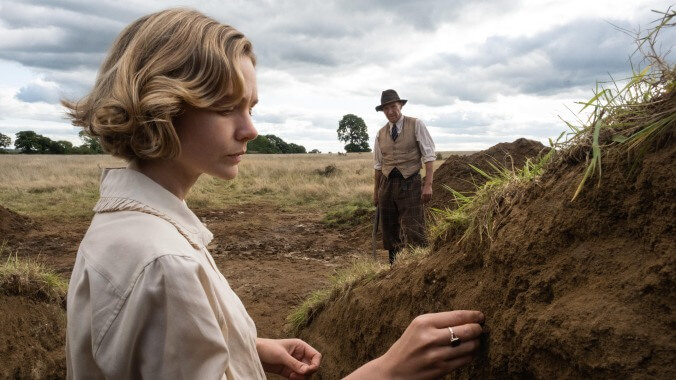Carey Mulligan and Ralph Fiennes delve for meaning in the sallow period drama The Dig
Film Reviews moviereview

Imagine a faded photograph of a bouquet of flowers. Blushing rose has mellowed into apricot and radiant gold into the color of wheat, as what was once a tangible object with weight and scent is reduced to a scrap of paper brittled by time. Someday soon, that paper will also disintegrate, a melancholy idea that’s expressed rather poetically in director Simon Stone’s otherwise stuffy adaptation of The Dig. The subjects of this period drama are buried treasure and repressed longing, ephemeral things that—much like flowers or photographs—crumble when they’re exposed to oxygen.
The film is based on John Preston’s 2007 novel, which dramatized the 1939 excavation of a sixth-century Anglo-Saxon ship burial near the English country enclave of Woodbridge. As one might expect from that quick succession of dates, time and the fleeting nature of human existence are major themes. And frankly, with an evocative metaphor right there at the center of the story—that would be the wooden vessel itself, a once-imposing structure compressed into mulch by centuries underground—you’d be a fool not to run with it. Indeed, every character in the film, which retains a novelistic scope, is carrying their own personal memento mori in their sallow British chest. But if time flies and life is short, why spend so much of it just hanging around?
Inertia defines The Dig, which has a confident visual style and a frustratingly halting approach to storytelling. At first, it seems as if we’re in for a love story. The picture of “ladylike” feminine fragility, Mrs. Pretty (Carey Mulligan) suffers from a heart ailment that makes her leisurely lifestyle a medical necessity as well as an aristocratic luxury. The widowed landowner spends her afternoons getting dressed for dinner in hopes that Basil Brown (Ralph Fiennes), the gruff, working-class archaeologist she’s hired to excavate a mysterious mound on her property, will join her. He never does, although Basil’s wife, May (Monica Dolan), knowingly notes Basil’s fondness for the invalid mistress of the manor and her precocious son, Robert (Archie Barnes).
The subtle, almost imperceptible undercurrent of eroticism in Pretty and Brown’s dynamic eventually fizzles out, which is just as well given that Mulligan and Fiennes’ chemistry really only works in the film’s scant moments of crisis. Still, Mulligan sits on the sideline, her emotional palette watered down into drawn expressions in stylish wool coats. Whatever assertiveness her character can muster is born of her upper-class status, and as with the landlord protagonist of the BBC-HBO period drama Gentleman Jack, the viewer is left to decide for themselves whether asserting one’s privilege as a landowner should count as female empowerment. But Pretty’s entitlement becomes invaluable when The Dig shifts into a genteel version of an ’80s “snobs vs. slobs” frat-party movie, as a condescending band of Ph.Ds from the British Museum threaten to separate Brown from his beloved dig.
Alas, as much as the British Museum deserves to be taken down a peg, that conflict doesn’t go anywhere either. But it does introduce a handful of new characters who will become integral to the plot. Chief among these is Lily James as Peggy Piggott, the neglected wife of archaeologist Stuart Piggott (Ben Chaplin); like Mrs. Pretty, Peggy is consumed by an emotional ache she can’t quite articulate. As the excavation unfolds, new discoveries at the dig site give everyone an intellectual shot in the arm—and, indeed, these are some of the more invigorating scenes in the movie. In between, everyone waits: for the rain to stop, for a verdict on who actually owns these newly unearthed treasures, for the distant thunder of war to explode over their heads—which it eventually does, to little lasting consequence.
As these modest narrative mile markers slowly tick by, Stone and cinematographer Mike Eley pass the time with elegant compositions—a pair of shots juxtaposing Brown and Pretty curled up like embryos in their respective beds are particularly beautiful—and stylized filmmaking techniques that both enhance and contrast with the period setting. The dusty, aged color scheme eloquently conveys the former, giving The Dig that faded-photograph quality mentioned up top. Meanwhile, the handheld, wide-angle camerawork in early scenes seems to promise aggressive visual revisionism à la The Favourite or Jackie. But this, too, is a train that never arrives. And so, by the time the storylines weave together into an elegiac statement about humanity as leaves floating on the stream of history, the effect is less profound rapture and more a muttered, “Finally.” For all the film’s sweeping, romantic ideas, the actual experience of watching The Dig is a lot like sitting at a bus stop.
13 Comments
Mrs. Pretty? But no Mr. Handsome?
Mrs Pretty, Mr Brown, and Peggy Piggott sound like characters in a subdued yet hilarious pastiche of uptight British period pieces. Or rejected Roger Hargreaves books…
I’ll wait for the Muppet version with Piggy Piggott.
Mrs Pretty. Basil Brown. Peggy Piggott. To me they sound like throwaway characters from a 1960s superhero comic.
And yet, those are real names of people involved in the excavation at Sutton Hoo. The real history is a bit soaped over in The Dig, but it’s still a decent Saturday night movie.
Delving in the Ralph is a gas; baby can you dig it?
Make Carey Mulligan and Lily James kiss, or no deal!
Yeah! This should’ve been Ammonite II: The Ammoniting.
Interesting that you went with “sallow” in the headline instead of “shallow”, considering that the film is called The Dig.
He’d better not have a Marshalltown pointing trowel.
Can’t believe the review doesn’t mention the bit where Mulligan goes space crazy and Fiennes has to chop off her arm. (The best part of The Dig is piecing together alien skeletons.)
following from which Mulligan uses her scientific brilliance to construct a machine-organic composite arm, that she uses to battle Fiennes, who has mutated after exposure to the dormant alien dna.
“sallow”? – like, yellowish and sickly?